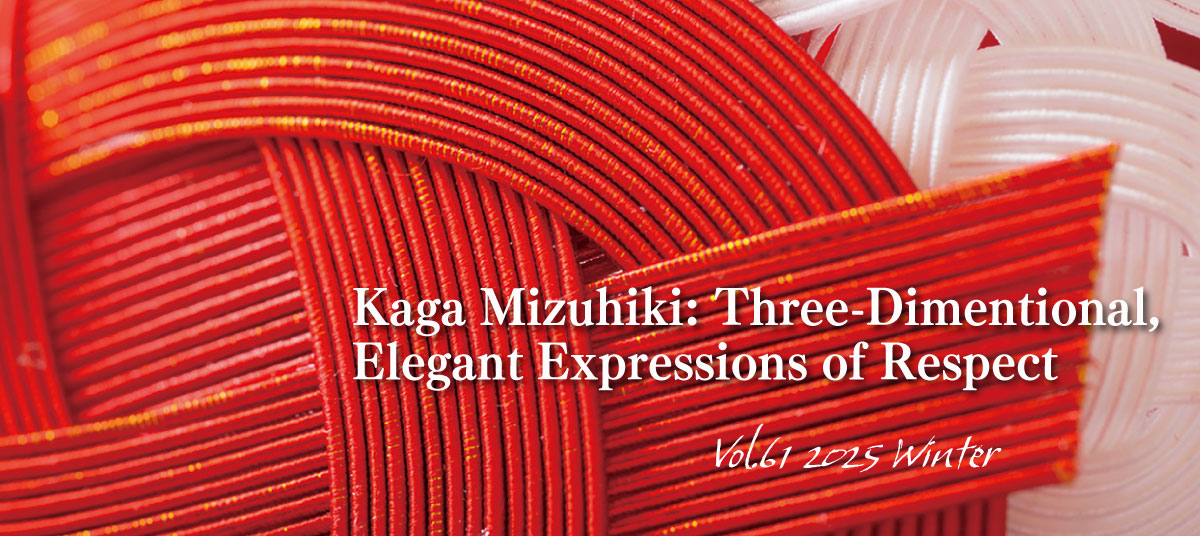
Mizuhiki, the traditional Japanese craft of decorating gifts and envelopes with paper cords, is part of many of life's milestones, including celebrations such as engagements and weddings, as well as solemn occasions. In recent years, Mizuhiki has become increasingly popular, going beyond formal events such as weddings and funerals to make a splash in everyday life. Mizuhiki is in the spotlight as an aesthetic art form that can be embodied in accessories that go well with both Japanese and Western fashions, and even as interior decorations that add color to various spaces. Tsuda Mizuhiki Orikata is the only atelier that uses Kaga Mizuhiki, the paper cord technique designated as a rare traditional craft of Ishikawa Prefecture. This article introduces the appeal of Kaga Mizuhiki, which is steeped in the elegance of Kaga Hyakumangoku (a popular name for the Kaga domain during the Edo period, literally meaning "a yield of one million koku of rice"), interspersed with explanations by Rokusuke Tsuda, the fifth generation master of this atelier.
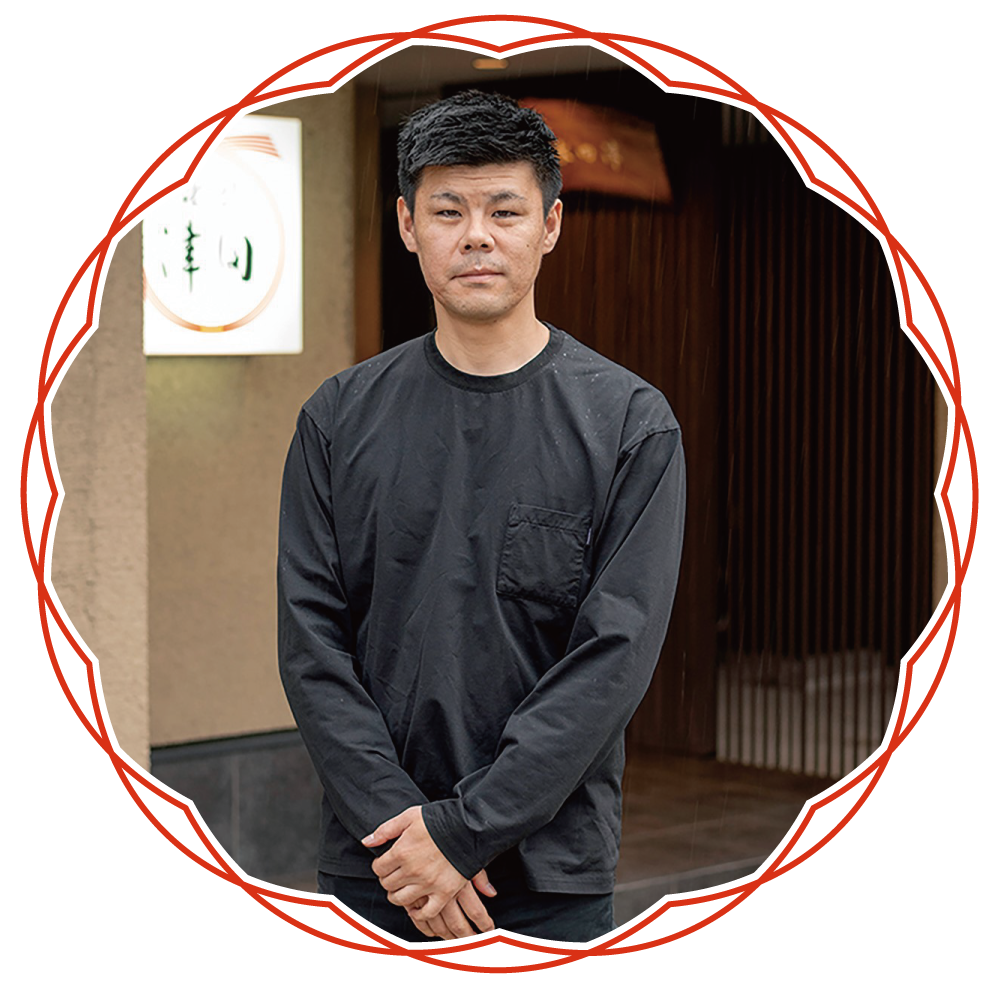
Rokusuke Tsuda
Fifth generation master of Tsuda Mizuhiki Orikata Kaga Mizuhiki
Kaga Mizuhiki
Tsuda Mizuhiki Orikata
Address: 1-1-36 No-machi, Kanazawa City, Ishikawa Prefecture
Tel: +81-76-214-6363
Open hours: 10 a.m.-6p.m. (weekdays) / 10 a.m.-12p.m. (Sat)
Closed: Sunday and national holidays Reservations and enquiries for mizuhiki hands-on classes must be made at least two business days in advance
Website: https://mizuhiki.jp/

Kaga Mizuhiki is a wrapping style that expresses sentiments
with beautiful wrapping instead of words.
My wish is to continue to foster connections
between people in a way that emphasizes the communication of feelings,
which is the essence of this craft.

Mizuhiki is a traditional craft born out of Japan’s unique etiquette of respecting others. It has become deeply rooted in our lifestyle in the form of gifts for weddings, births, or engagements, as well as decorations to welcome in the New Year. “Simply put, mizuhiki is traditional Japanese wrapping,” says Rokusuke Tsuda of Tsuda Mizuhiki Orikata, the heir to the rare traditional craft Kaga Mizuhiki in Kanazawa City, Ishikawa Prefecture. As the fifth generation master of a venerable Kaga Mizuhiki atelier with over 100 years of history, he continues to create traditional engagement gifts and congratulatory envelopes using the folding patterns and mizuhiki techniques invented by the atelier’s founder, Sokichi Tsuda.
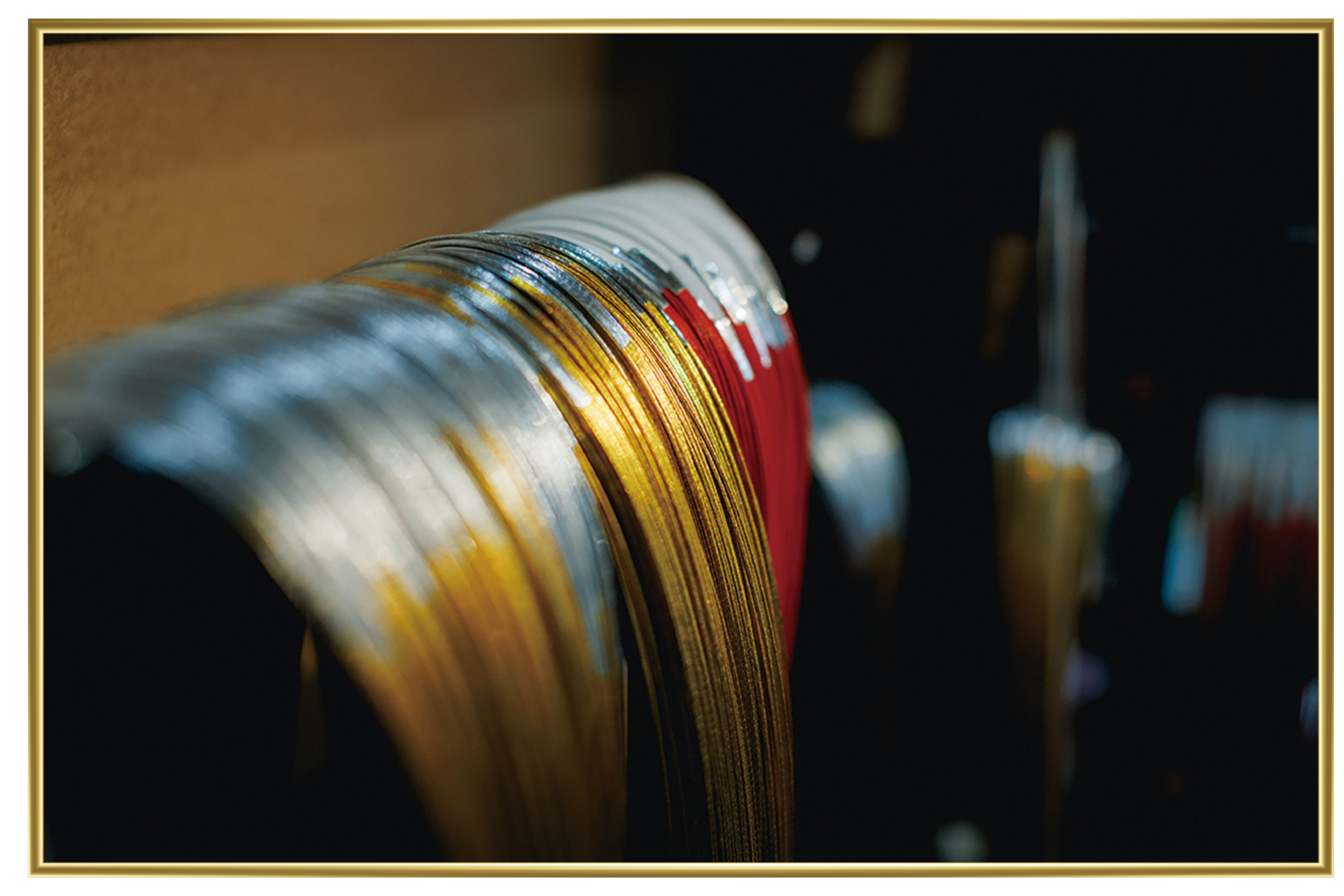

"Many people associate mizuhiki with red-and-white or black-and-white decorative cords attached to paper-wrapped gifts.
They are not wrong, but the basis of Mizuhiki Orikata is to 'wrap' the gift in white washi Japanese paper, 'tie' it with mizuhiki cords and 'write' the giver's sentiments and name. Only when all three elements are present is the mizuhiki complete. Rather than using direct words to convey their sentiments for the recipient, the giver uses a combination of wrapping techniques and mizuhiki craftsmanship, colors and knots, and elegant brush strokes to communicate feelings indirectly. Mizuhiki is a style of wrapping that expresses the graceful sensitivity and discreet consideration that is unique to the Japanese," says Rokusuke Tsuda.
Japanese culture is also known as a "culture of perception." As a way of expressing one's feelings indirectly and with a modest attitude, mizuhiki can be described as a sophisticated culture born out of the elegance, aesthetics, and delicacy that the Japanese people have always cherished.
Mizuhiki is made by twisting long, thin strips of paper into cords, coating them with water-based glue and leaving them to dry until the cords have hardened. There are mizuhiki cords wrapped with silk threads instead of paper, cords made of twisted colored paper wrapped with a film of lame threads, and hundreds of other varieties of mizuhiki that combine different colors, materials, gloss, and wrapping techniques.
As a craft, mizuhiki has a long history.One theory places its origins in the Asuka period (592-710), another in the Muromachi period (1336-1573), when trade between Japan and Ming Dynasty China (1336-1568) commenced. "There is a theory that the origins of mizuhiki can be traced back to the time of Prince Shotoku during the Asuka period and the red-and-white cords used to tie and decorate the gifts brought back to Japan by Ono no Imoko, the official envoy to the Chinese Sui dynasty.
There are various explanations for the original purpose of these cords, including that they were used as amulets to protect against pirates and maritime accidents in Sino-Japanese trade, to prove that the gifts were unopened and the contents had not been exchanged, and to wish for a long-lasting friendship between China and Japan," explains Tsuda. The custom of wrapping gifts with cords became a prestigious practice of the aristocracy through the Ogasawara school of etiquette. In the late Meiji era (1868-1912), the founder of Tsuda Mizuhiki Orikata, Sokichi Tsuda, studied the principles of the Ogasawara school and later, around 1915, set up his own business arranging the exchange of gifts at traditional Japanese engagement ceremonies. However, the intricate shapes of the engagement gifts and congratulatory envelopes made it difficult to fold and wrap them tightly, so after much trial and error he decided to leave them looking plump and deliberately unfolded, wrapping them instead with mizuhiki cords. The result was voluminous and gorgeous-looking forms with no noticeable technical imperfections.

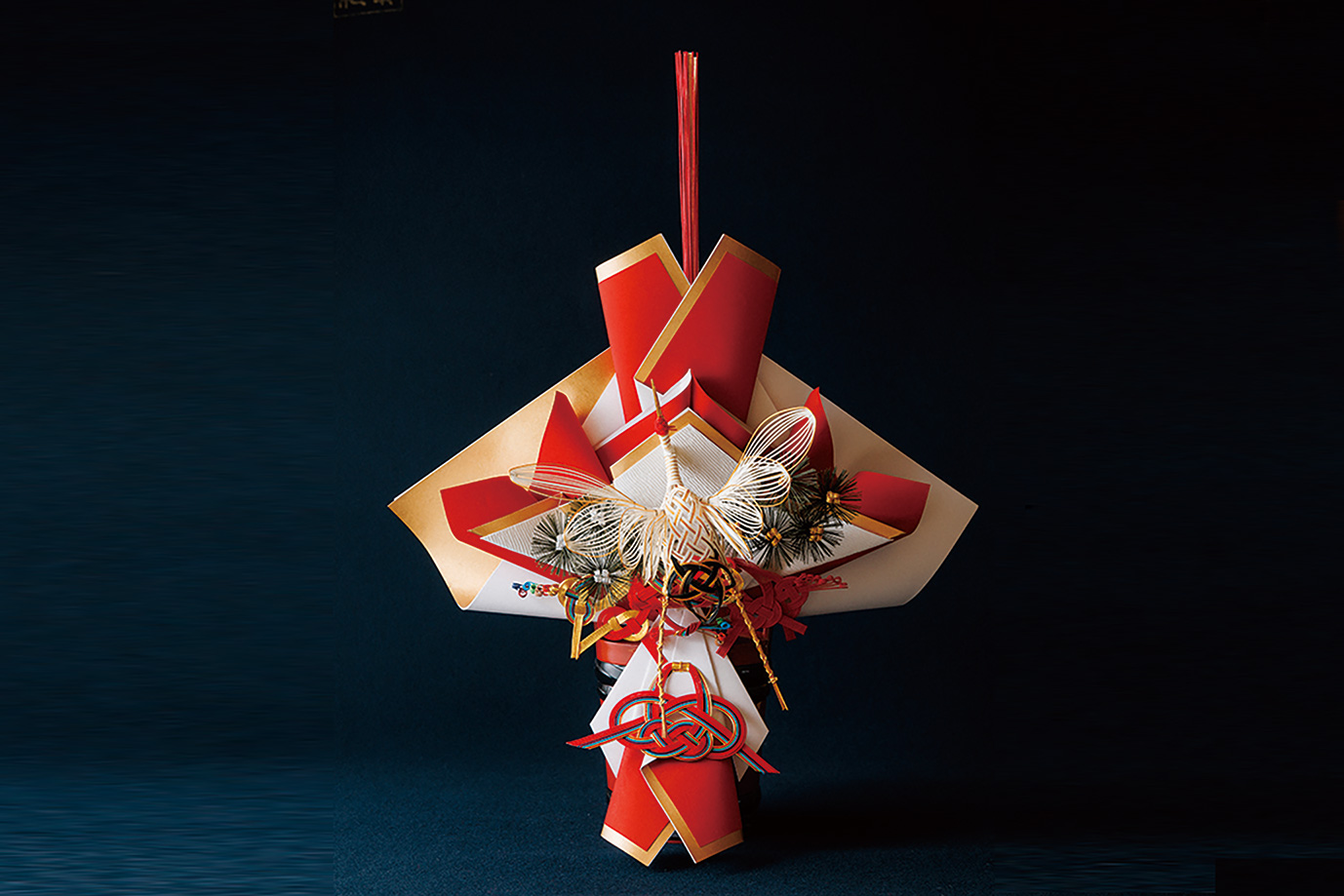
A gorgeous sake barrel decoration for wedding receptions and other occasions
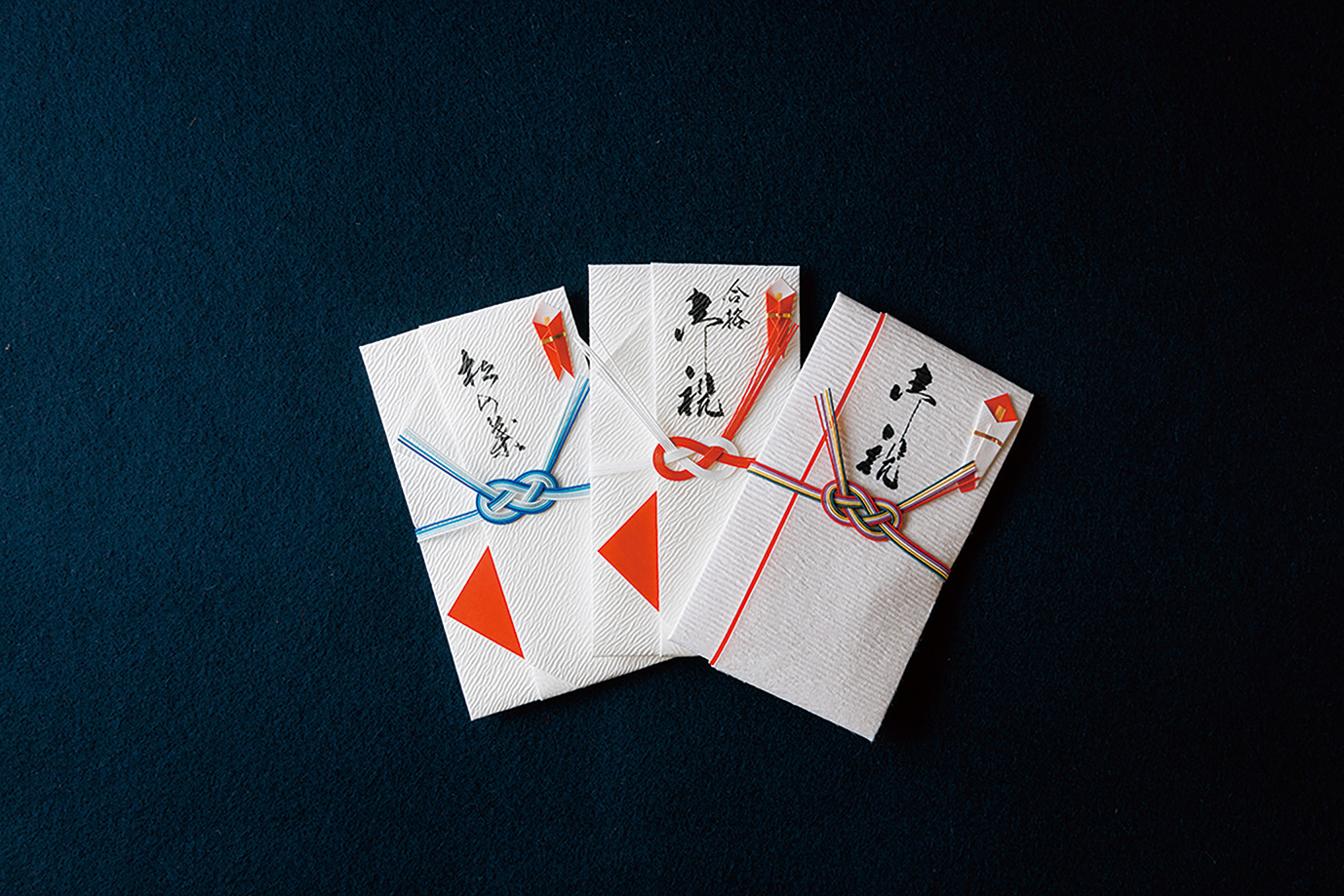
Congratulatory envelopes sold at Tsuda Mizuhiki Orikata. The atelier also offers writing services tailored to the shape and design of the envelope.
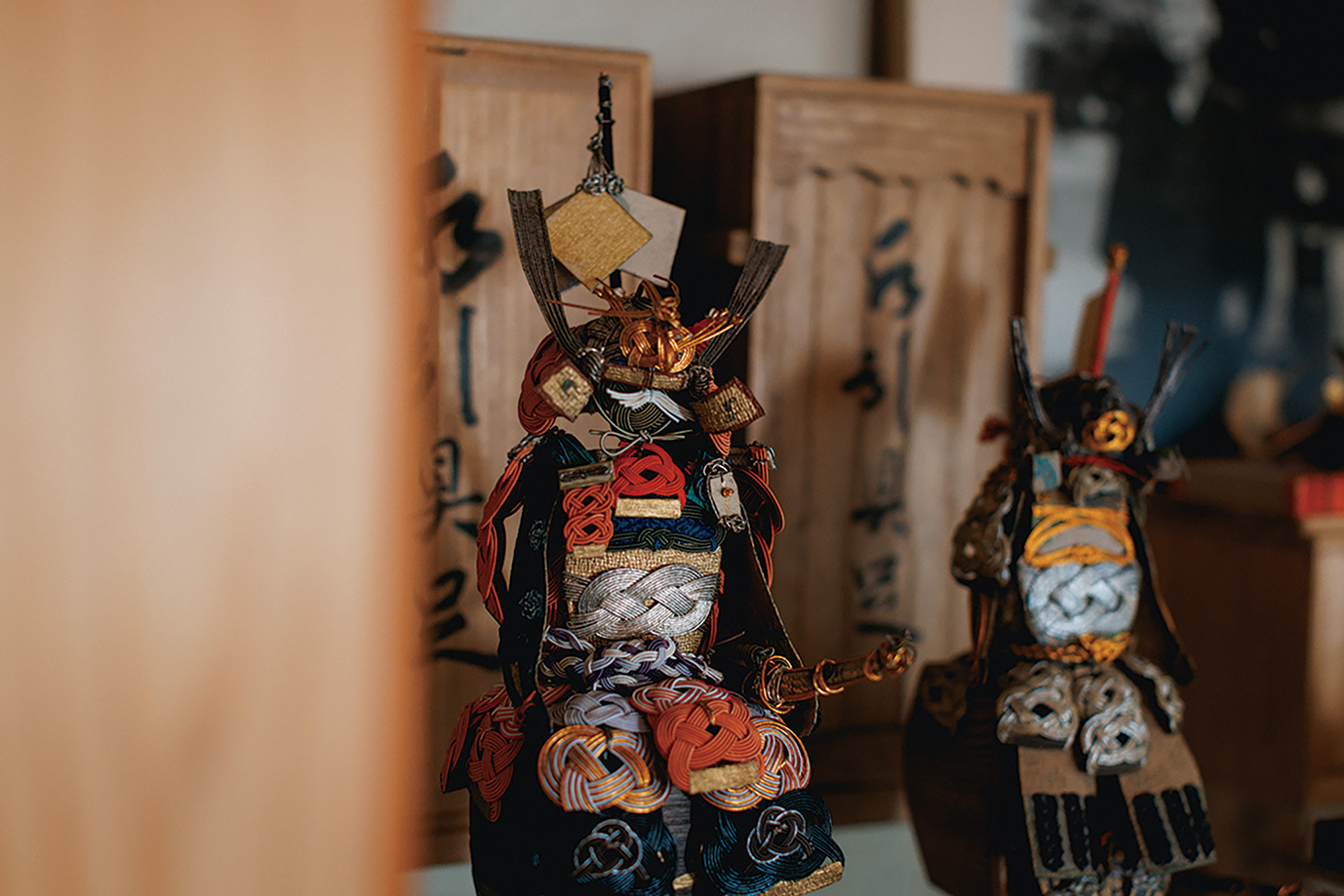
A complete set of armor made from mizuhiki cords by the second generation master Ume Tsuda.
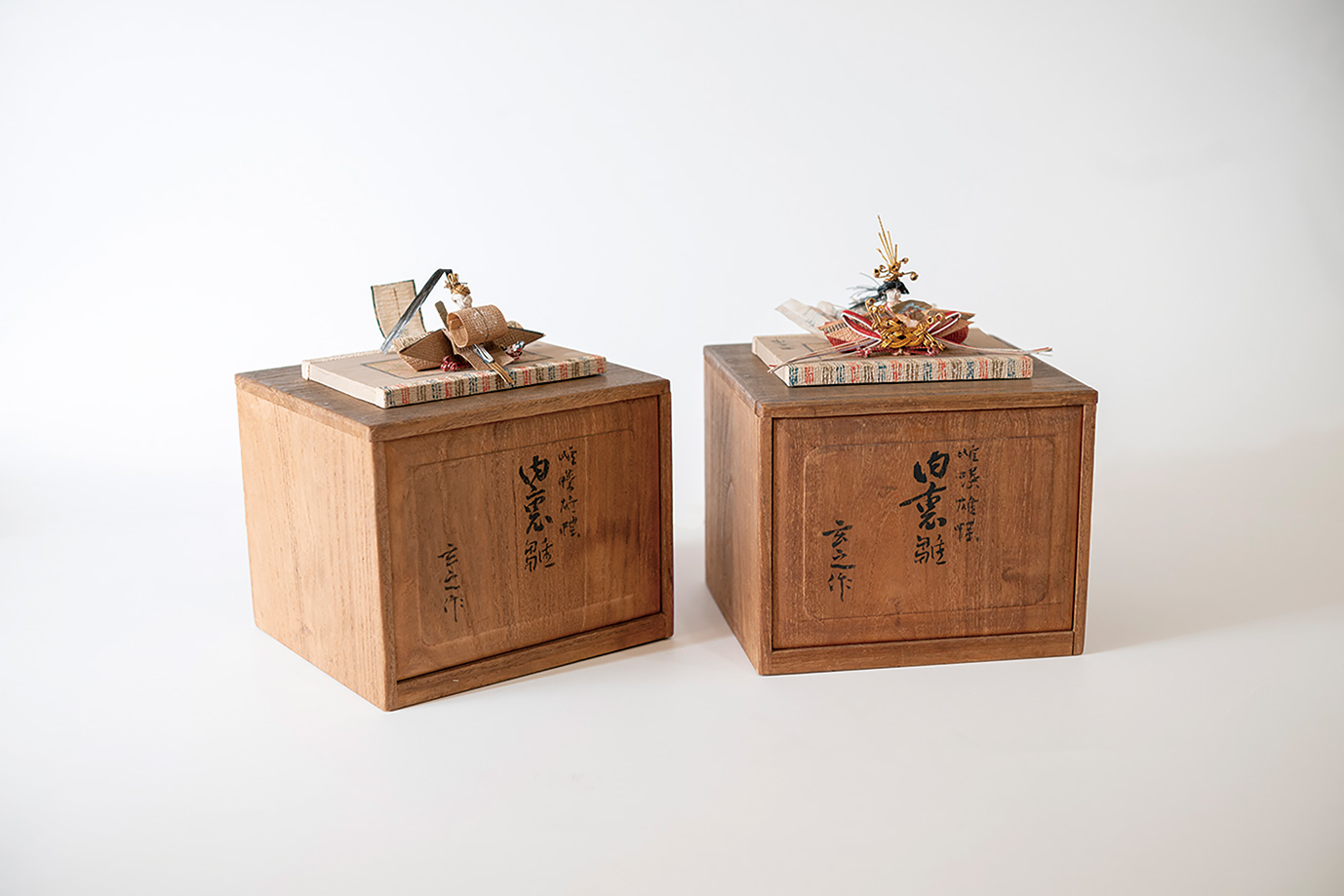
Imperial Hina dolls (dairibina) made about 100 years ago by the founder of Kaga Mizuhiki, Sokichi Tsuda. In 1924, he presented the Hina dolls and a set of armor to the emperor. In 1926, he presented Hina dolls to his childhood friend, the writer Kyoka Izumi.
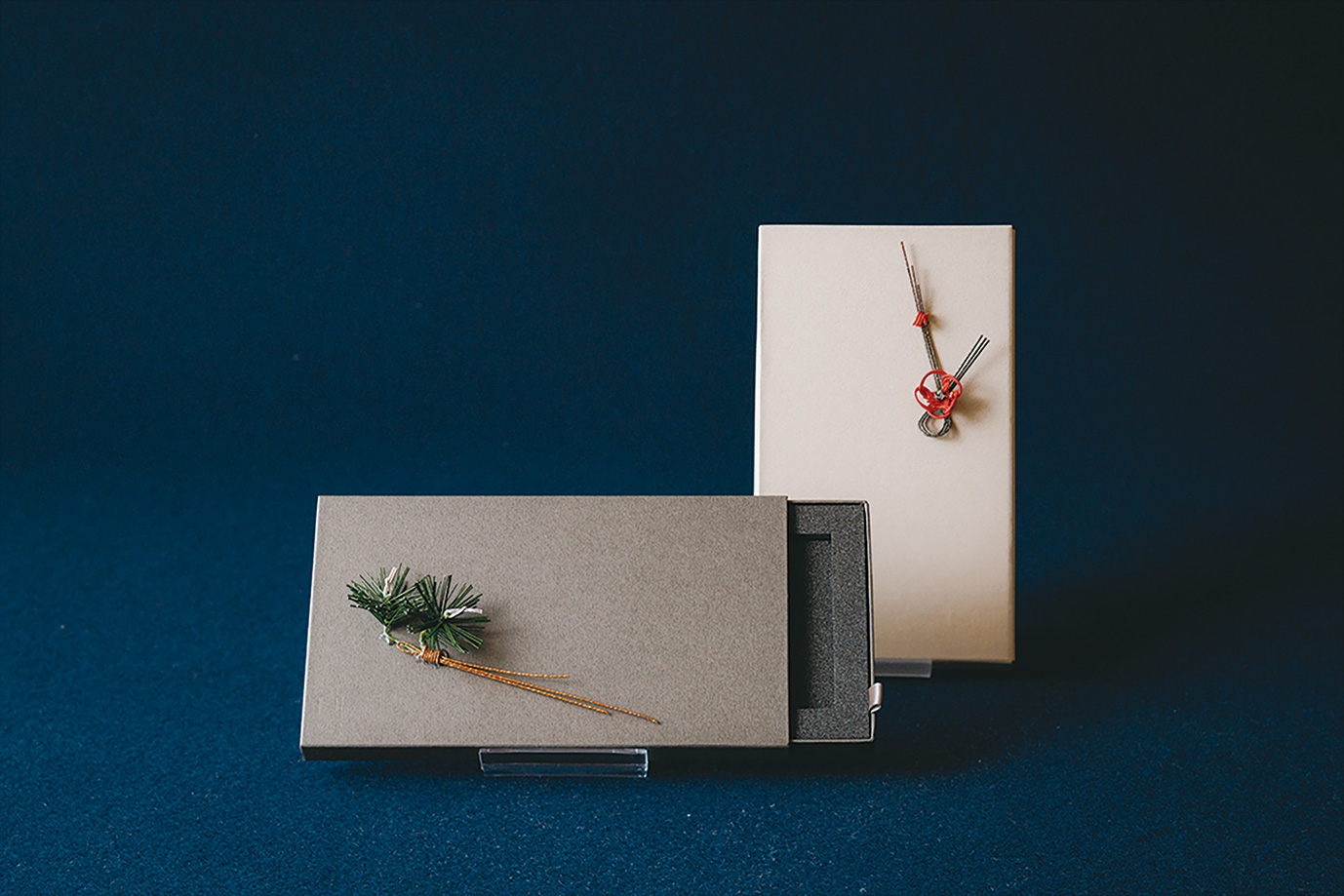
The "wrap" celebratory envelope, designed as a "wrapping to present banknotes."
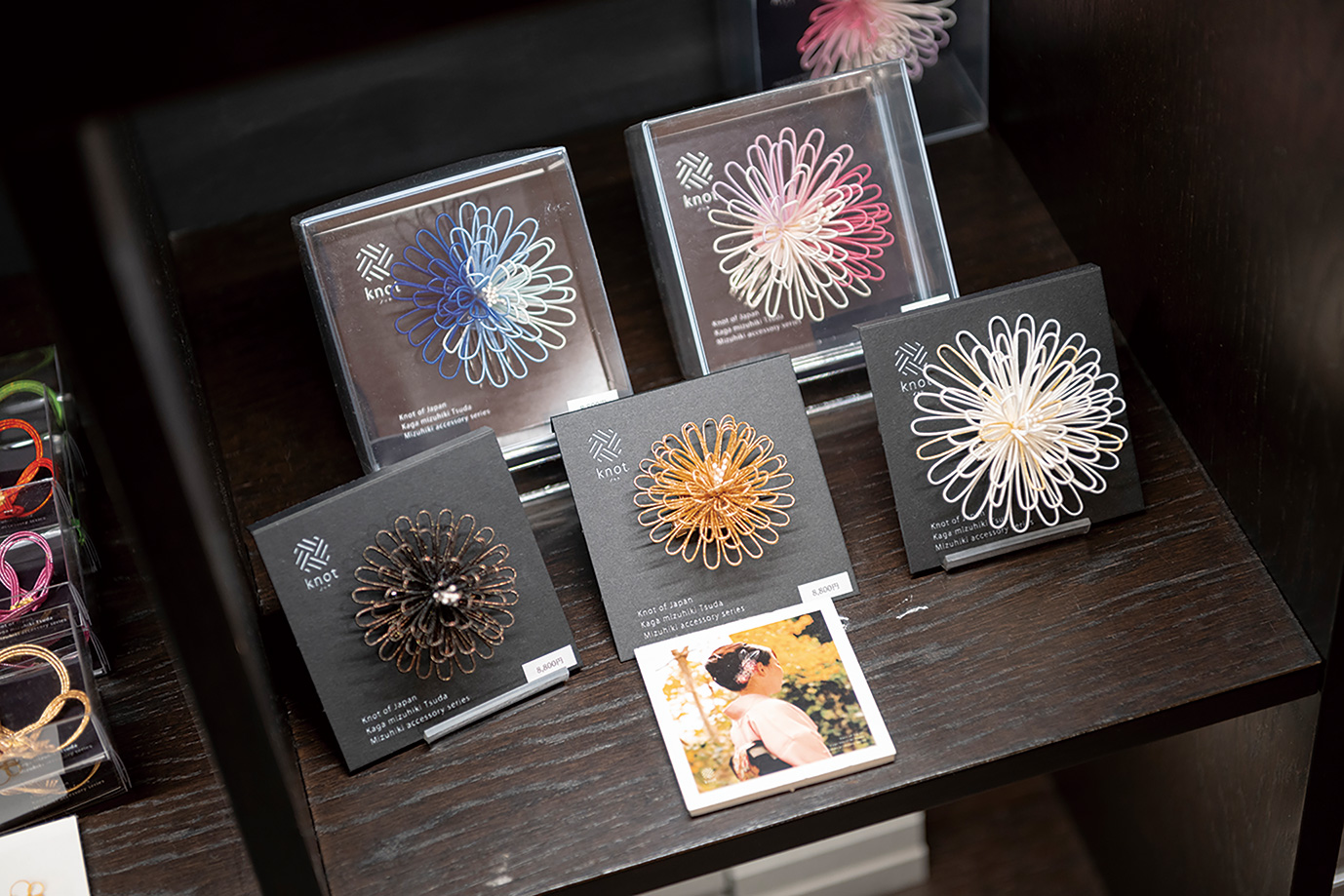
Mizuhiki corsages are suitable for both Japanese and Western clothing.
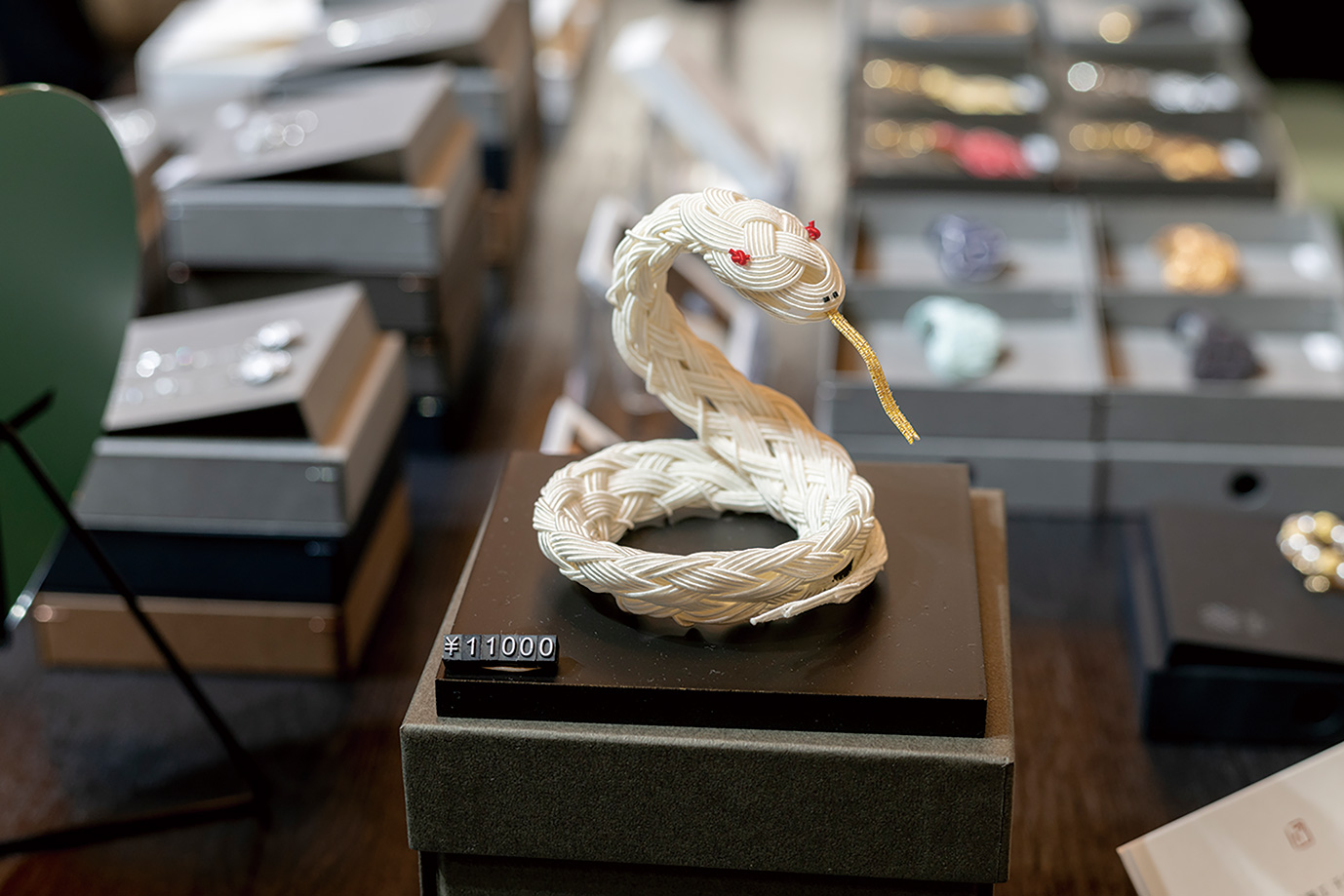
A snake, the Chinese zodiac sign for 2025, created by weaving mizuhiki.

The mizuhiki craftsmanship involved in this process also developed into an original style, using the basic "awaji knot," to create three-dimensional representations of auspicious symbols such as cranes and turtles, as well as pine, bamboo, and plum trees. When asked about the style of his work, Sokichi Tsuda apparently described it as "mucha kucha (chaotic) style." However, this new style that offered gorgeous arrangements based on the principles of the Ogasawara school was widely accepted by the public and Sokichi Tsuda received numerous honors, including an order from the Imperial Household. By the second generation, this style had become established as "the rare traditional craft Kaga Mizuhiki" and was well known throughout the country.
The brilliant founder Sokichi Tsuda also visited Iida City in Nagano Prefecture, a region known for the production of paper threads used to make elaborate mizuhiki cords, with a collection of designs he had created. In exchange for sharing with local manufacturers the ideas that inspired his original designs, he asked them to produce paper cords in new colors, thereby expanding the expressive range of the craft.
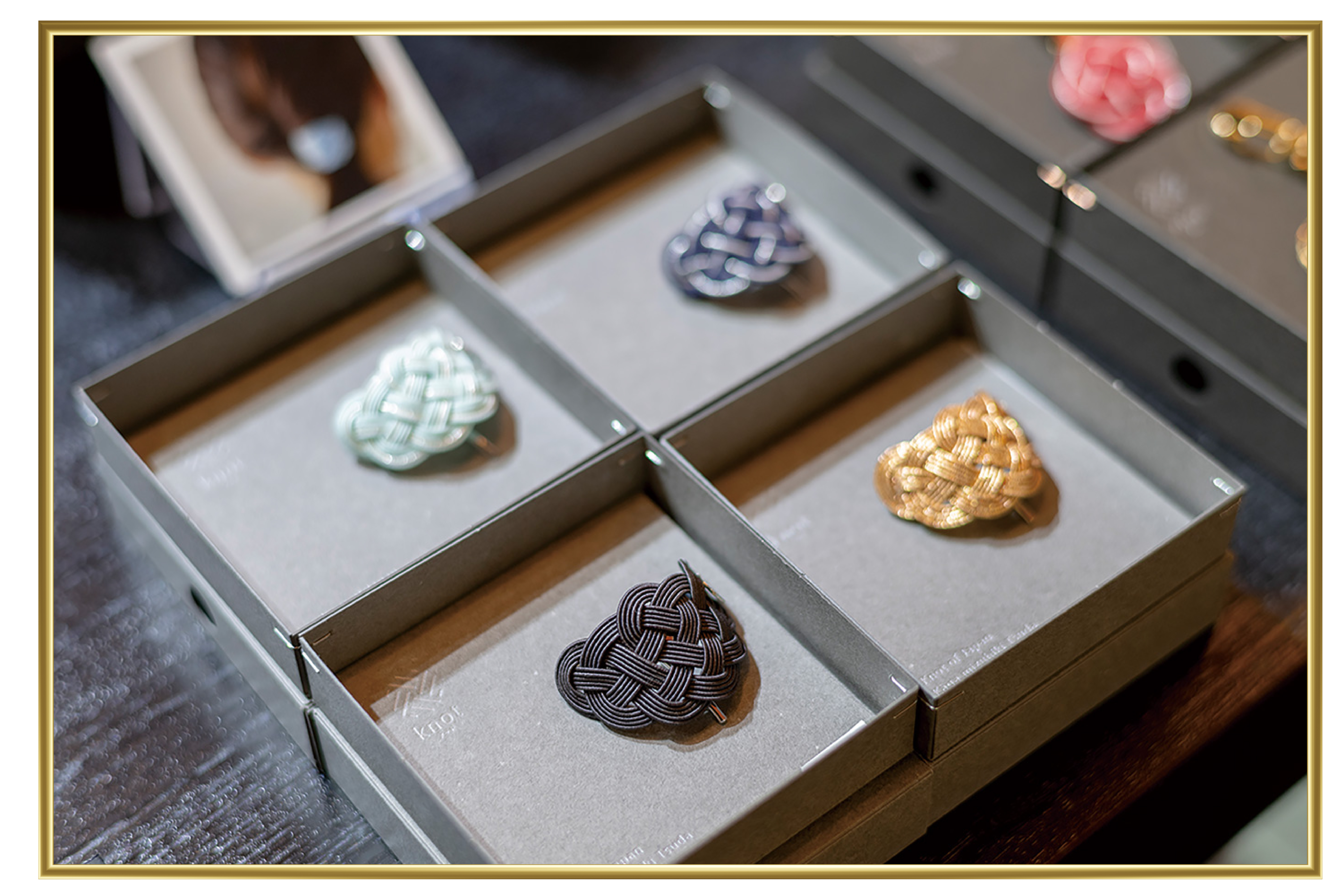
The mizuhiki accessory brand "knot."
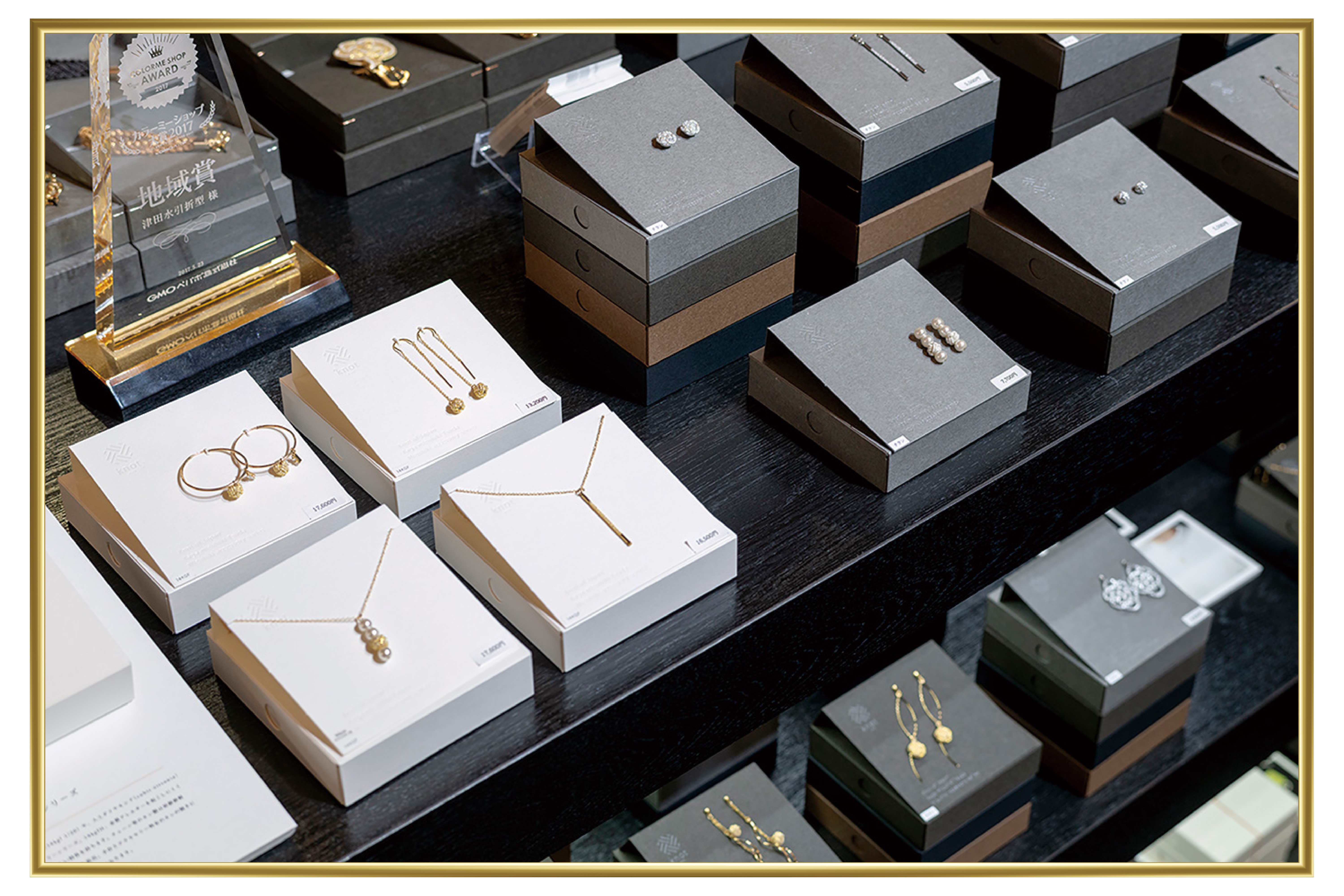
In addition to accessories, the brand also offers a range of tableware and wedding products.
Rokusuke Tsuda was born into the Tsuda family, the sole heirs to the Kaga Mizuhiki craft, and after graduating from university he joined an Internet-related company without taking over the family business. He worked in web planning and design, programming, and online shopping for about 10 years.
The incentive to take over the family business came with the opening of the Hokuriku Shinkansen line between Tokyo and Kanazawa in 2015. He decided to pursue mizuhiki as a career, believing that more and more people would visit Kanazawa, and that its traditional crafts would definitely attract attention.
"I have enjoyed making things since childhood and have had the opportunity to observe the mizuhiki craft as part of my daily life, but it was not until I started working here that I began to learn all the fundamentals. What helped me even more than learning the techniques was, quickly becoming aware of the essence of mizuhiki. It is important to preserve the traditional craft of Kaga Mizuhiki, which has been handed down from generation to generation for more than 100 years, but what is essential is not the technique, but the ability to convey the respect the giver has for the receiver and to create a communication that connects hearts and minds. I have come to believe that if we use this as a starting point to determine what can and cannot be changed, we can develop a new style of craftsmanship."
Having intuitively identified the true purpose and meaning of mizuhiki, Tsuda began to develop new products to meet the needs of the times in parallel with the production of traditional mizuhiki.
He launched a brand of accessories such as earrings, necklaces, and hair ornaments using the techniques of mizuhiki craftsmanship. The name of this brand, "knot," not only conveys the nature of mizuhiki, but also superimposes the negative word "not" to represent the brand's deviation from the original essence of the craft.
"I think it would be great if these accessories could provide an opportunity for people to learn about the beauty of mizuhiki and its original meaning. Many customers buy them because of their attractive appearance, but I think that rather than having the nature and background of the craft explained to them on the spot, people who become interested will learn more by looking it up later."
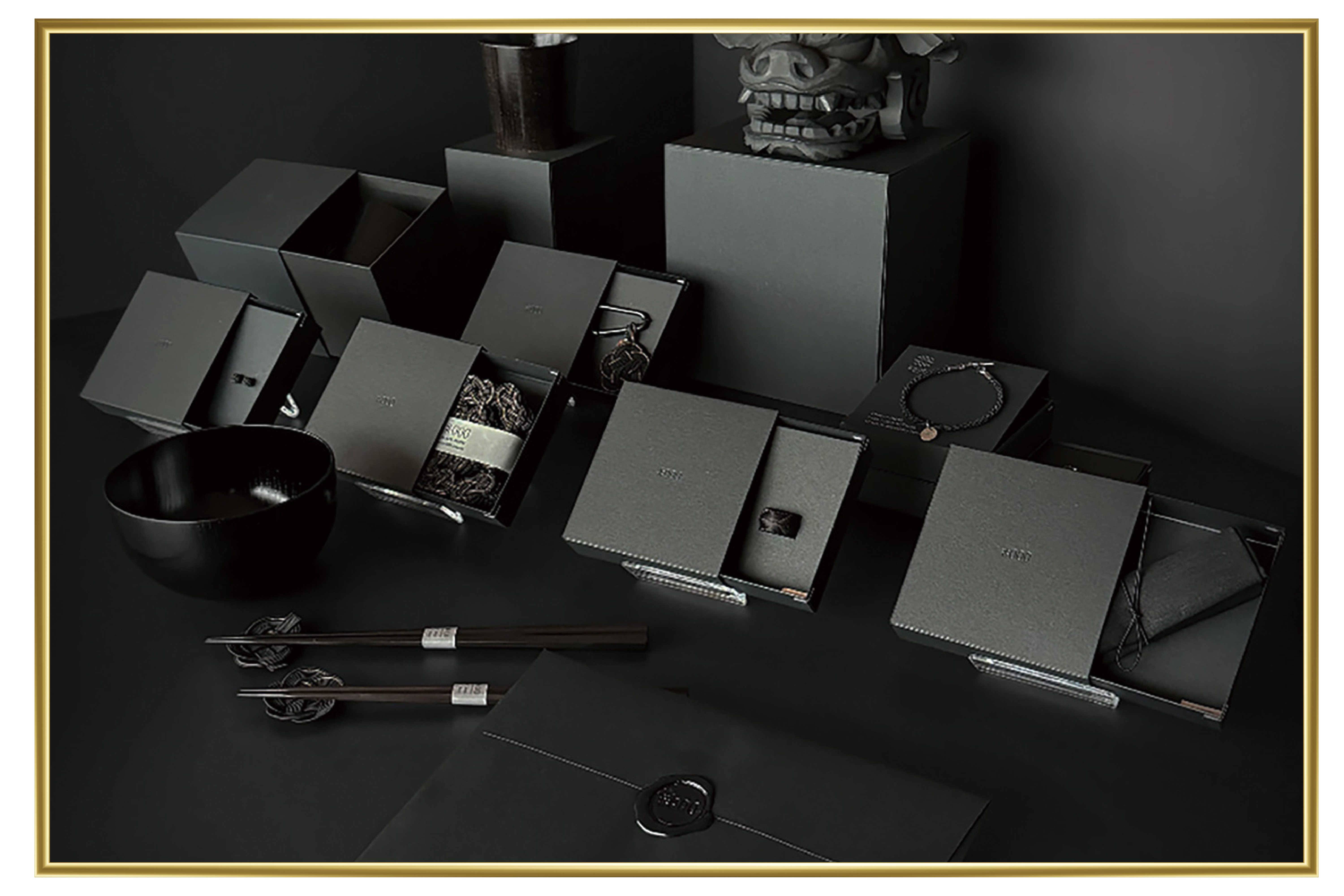
The "#000 BLACK KOGEI" features an all-black lineup of craftworks.
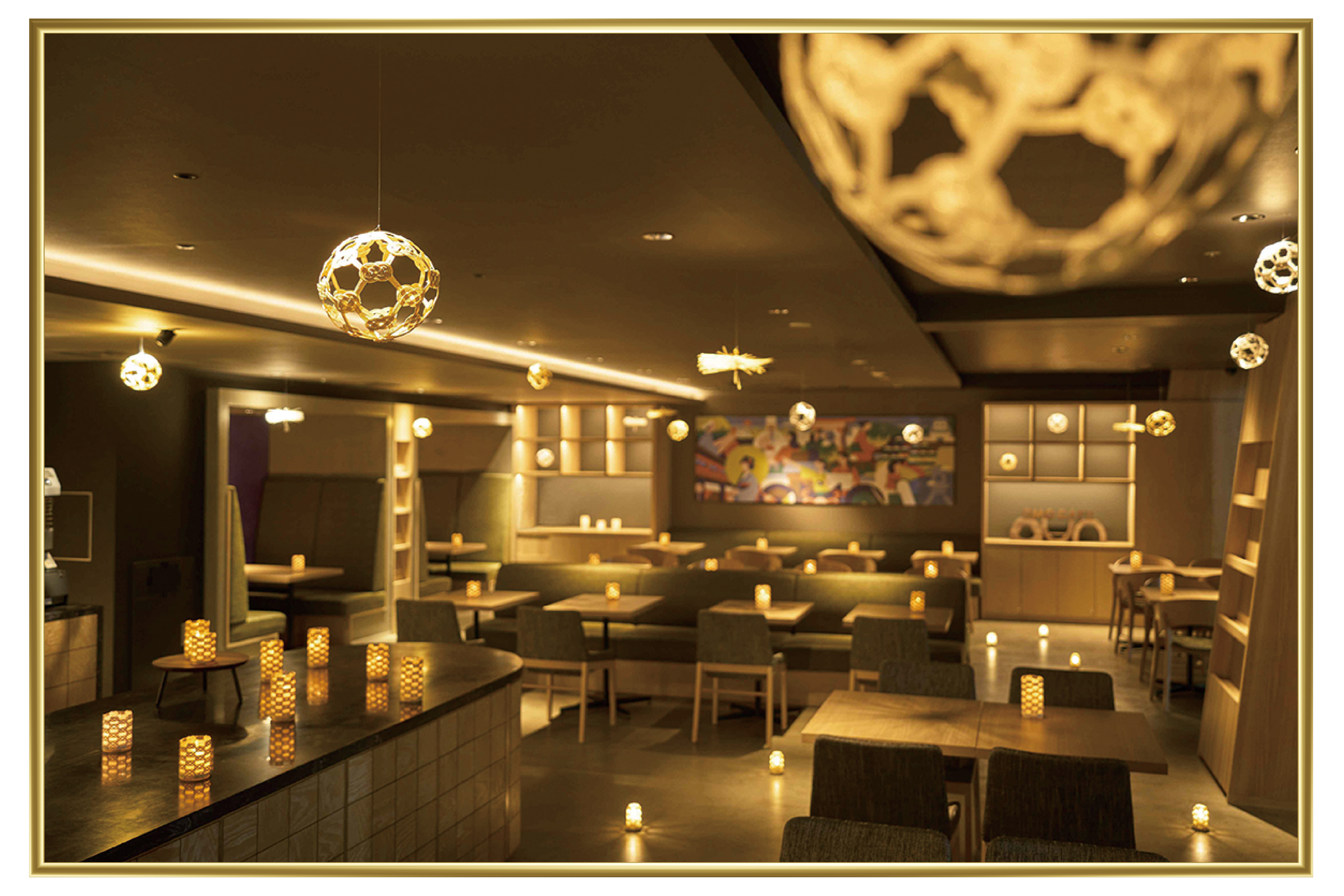
The interior of a Kaga Mizuhiki-themed collaboration cafe, with spatial decorations by Tsuda Mizuhiki Orikata. Open at night only on the 1st floor of OMO5 Kanazawa Katamachi by Hoshino Resorts.
The atelier offers many other products that were developed as modern communication tools, while retaining the true essence of the craft as a way of conveying the sentiments and thoughts of the giver to the receiver. It has developed a series of products that focus on the essentials, such as "wrap," a brand of congratulatory envelopes stripped of unnecessary functions, and "#000 BLACK KOGEI," a brand of traditional Kanazawa craftworks such as Kaga lion heads and Kaga embroidered balls colored entirely in black to highlight the beauty of their forms.
"We also produce and supervise one-off works of art using mizuhiki craftsmanship commissioned by companies and hotels, and conduct exhibitions of installation pieces, all with the aim of raising awareness of the essential nature of mizuhiki, I would be happy if my mizuhiki work could bring people closer to the essence of this craft, even if only in a small way."
Kaga Mizuhiki is a paper craft that transforms gifts into something much more personal and thoughtful. We invite readers to consider it when giving a gift to a loved one.

Exhibition events
Scheduled exhibitions showcase the "knot" and "#000 BLACK KOGEI" brands
①Kanazawa, Kaga, Noto Exhibition
Period: Jan 11 (Sat) - 17 (Fri) Venue: Hankyu Department Store Umeda Main Store 9F
②Fun Traditional Crafts
Period: Feb 25 (Tue) - Mar 3 (Mon) Venue: Sago Yokohama Department Store 6F
③Kyoto Crafts Exhibition DIALOGUE
Period: Mar 12 (Wed) - 15 (Sat) Venue: Hotel Kanra Kyoto

